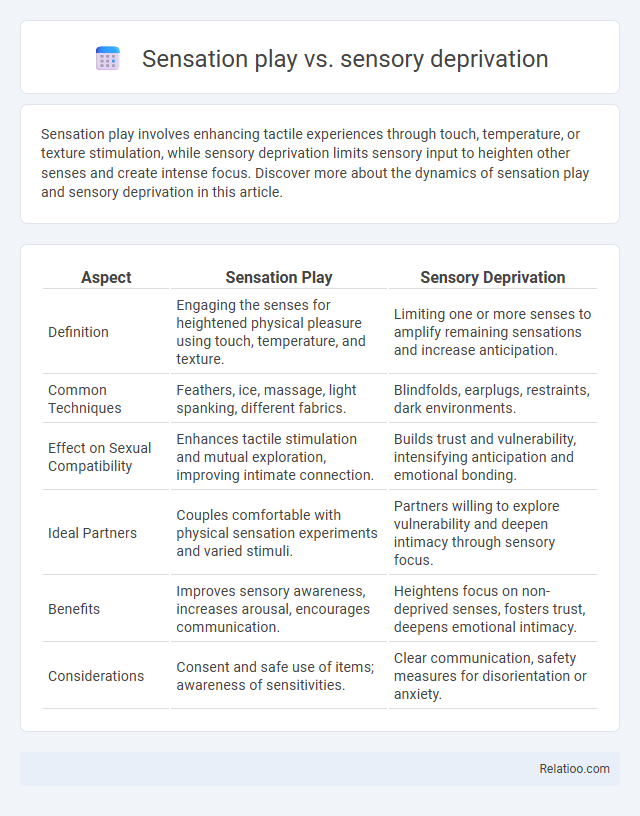Sensation play involves enhancing tactile experiences through touch, temperature, or texture stimulation, while sensory deprivation limits sensory input to heighten other senses and create intense focus. Discover more about the dynamics of sensation play and sensory deprivation in this article.
Table of Comparison
| Aspect | Sensation Play | Sensory Deprivation |
|---|---|---|
| Definition | Engaging the senses for heightened physical pleasure using touch, temperature, and texture. | Limiting one or more senses to amplify remaining sensations and increase anticipation. |
| Common Techniques | Feathers, ice, massage, light spanking, different fabrics. | Blindfolds, earplugs, restraints, dark environments. |
| Effect on Sexual Compatibility | Enhances tactile stimulation and mutual exploration, improving intimate connection. | Builds trust and vulnerability, intensifying anticipation and emotional bonding. |
| Ideal Partners | Couples comfortable with physical sensation experiments and varied stimuli. | Partners willing to explore vulnerability and deepen intimacy through sensory focus. |
| Benefits | Improves sensory awareness, increases arousal, encourages communication. | Heightens focus on non-deprived senses, fosters trust, deepens emotional intimacy. |
| Considerations | Consent and safe use of items; awareness of sensitivities. | Clear communication, safety measures for disorientation or anxiety. |
Understanding Sensation Play
Understanding sensation play involves exploring how various tactile stimuli, from light touches to intense pressures, enhance sensory experiences. Sensory deprivation contrasts this by intentionally reducing or eliminating sensory input, heightening awareness of subtle sensations when reintroduced. Your exploration of sensation play allows you to discover how differing intensities and types of stimuli affect physical and emotional responses.
What is Sensory Deprivation?
Sensory deprivation involves intentionally limiting or removing stimuli from one or more senses, such as sight, sound, or touch, to enhance other sensory experiences or heighten emotional awareness. Unlike sensation play, which focuses on stimulating the senses through varied textures, temperatures, or pressures, sensory deprivation creates a contrast by restricting input, often using blindfolds, earplugs, or restraints. Understanding the differences helps you explore the full spectrum of sensory experiences, whether seeking heightened sensitivity or a calming escape.
Key Differences Between Sensation Play and Sensory Deprivation
Sensation play involves the deliberate stimulation of the senses using different textures, temperatures, or pressures to enhance tactile experiences, while sensory deprivation restricts one or more senses to heighten awareness of remaining senses. Key differences lie in their approach: sensation play seeks to amplify sensory input, whereas sensory deprivation reduces or eliminates it to induce heightened focus or relaxation. Both techniques are used to explore sensory boundaries but create contrasting experiential outcomes through either excess or absence of sensory stimuli.
Psychological Effects of Sensation Play
Sensation play involves stimulating the senses through touch, temperature, or texture, enhancing emotional intimacy and heightening arousal by activating your nervous system in diverse ways. Sensory deprivation, conversely, restricts sensory input, which can increase focus and relaxation by reducing external distractions, often creating a heightened internal awareness. Understanding the psychological effects of sensation play reveals its ability to evoke trust, vulnerability, and intense presence, contributing to stronger emotional bonds and a deeper connection between partners.
Psychological Effects of Sensory Deprivation
Sensory deprivation involves the intentional reduction or removal of sensory stimuli, leading to heightened internal awareness and altered psychological states such as deep relaxation or anxiety depending on individual responses. This contrasts with sensation play, which uses varied tactile stimuli to stimulate sensory perception and evoke emotional or physical reactions, often enhancing arousal and mindfulness. Research indicates that sensory deprivation can induce changes in brain activity, promoting neuroplasticity and stress relief while also posing risks like disorientation or emotional distress if prolonged.
Common Practices and Tools for Each Experience
Sensation play commonly incorporates feathers, ice cubes, and massage oils to stimulate various sensory receptors, enhancing physical pleasure and heightening awareness. Sensory deprivation uses blindfolds, earplugs, and restraints to block sight, sound, or touch, intensifying other senses and creating a unique psychological experience. Your exploration of these experiences benefits from understanding that sensation play prioritizes varied stimuli, while sensory deprivation emphasizes the reduction of sensory input to deepen focus and arousal.
Safety Considerations for Both Activities
Sensation play and sensory deprivation involve manipulating physical stimuli to enhance experiences, requiring strict attention to safety protocols to prevent injury or distress. Your safety depends on clear communication, consent, and understanding individual limits to manage risks such as nerve damage or psychological discomfort during sensation play or sensory deprivation. Proper preparation, continuous monitoring, and aftercare are essential to ensure both activities are enjoyable and safe.
Communication and Consent in Sensory Play
Effective communication and informed consent are fundamental in all aspects of sensation play, sensory deprivation, and mixed sensation play to ensure safety and mutual enjoyment. Clear dialogue about boundaries, triggers, and safe words enables participants to explore sensory experiences while maintaining trust and comfort. Prioritizing consent prevents physical and emotional harm, making sensory play a positive and consensual encounter for everyone involved.
Exploring Sensation Play and Sensory Deprivation for Beginners
Exploring sensation play and sensory deprivation reveals distinct approaches to enhancing sensory experiences; sensation play involves stimulating the senses through textures, temperatures, or light touch, heightening physical awareness and pleasure. Sensory deprivation, by contrast, reduces or removes sensory input--such as using blindfolds or earplugs--to intensify remaining senses and deepen focus on bodily sensations. Beginners benefit from understanding these techniques to safely experiment with boundaries, trust, and sensory perception during intimate or therapeutic practices.
Enhancing Intimacy Through Sensory Exploration
Sensation play involves stimulating your senses through touch, temperature, or textures to heighten physical and emotional connection. Sensory deprivation reduces or removes sensory input, such as vision or sound, to amplify remaining senses and intensify intimacy. Both techniques deepen trust and communication, allowing partners to explore new dimensions of pleasure and connection.

Infographic: Sensation play vs Sensory deprivation
 relatioo.com
relatioo.com